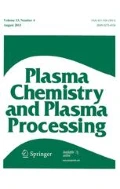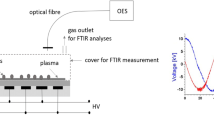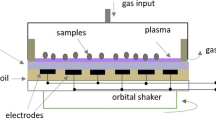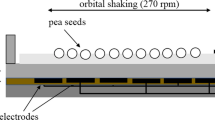Abstract
Great attention is currently being paid to the application of non-thermal plasma in agriculture. Seed germination is the first and critical time in the life cycle of each plant. Cold atmospheric pressure plasma (CAPP) generated by Diffuse Coplanar Surface Barrier Discharge, working at atmospheric pressure in ambient air, oxygen or nitrogen atmosphere in different time applications (60, 180, 300 s) was used to investigate its influence on early stages of germination processes in pea (Pisum sativum L. cv. Prophet). For evaluation of physiological parameters germination, the imbibition rate, percentage of germination, germination potential, germination index, seeds and seedlings vitality index, and seedlings length index were determined. In this work, also CAPP influence on dehydrogenases and lytic enzymes (amylase, glucanase and protease) as well as genotoxic effects were studied. Infrared spectra of pea seeds surface demonstrate that reactive oxygen and nitrogen species as well as UV radiation produced in plasma cause oxidation of lipids and polysaccharides on the surface of samples and lead to increase of wettability related to increased imbibition which can accelerate germination. A significant positive effect had mainly CAPP generated in air and nitrogen atmosphere at treatment time of 60 s on the studied germination and growth parameters and overall activation of lytic enzymes in pea seeds compared to untreated control. Increased concentrations of radicals in young 3-day old seedlings and activation of antioxidant enzymes suggest that low plasma doses act as low stress, which paradoxically has a stimulating effect on germination, growth and development of seedlings.













Similar content being viewed by others
References
Morent R, De Geyter N (2011) Inactivation of bacteria by non-thermal plasmas. In: Biomed Eng Challenges, pp 25–50
Park G, Park S, Choi M et al (2012) Atmospheric-pressure plasma sources for biomedical applications. Plasma Sources Sci Technol 21:043001
Puač N, Gherardi M, Shiratani M (2018) Plasma agriculture: a rapidly emerging field. Plasma Process Polym 15:1700174
Meiqiang Y, Mingjing H, Buzhou M, Tengcai M (2005) Stimulating effects of seed treatment by magnetized plasma on tomato growth and yield. Plasma Sci Technol 7:3143
Dubinov AE, Lazarenko EM, Selemir VD (2000) Effect of glow discharge air plasma on grain crops seed. IEEE Trans Plasma Sci 28:180–183
Stolárik T, Henselová M, Martinka M et al (2015) Effect of low-temperature plasma on the structure of seeds, growth and metabolism of endogenous phytohormones in pea (Pisum sativum L.). Plasma Chem Plasma Process 35:659–676
Bormashenko E, Grynyov R, Bormashenko Y, Drori E (2012) Cold radiofrequency plasma treatment modifies wettability and germination speed of plant seeds. Sci Rep 2:3–10
Kyzek S, Holubová Ľ, Medvecká V et al (2019) Cold atmospheric pressure plasma can induce adaptive response in pea seeds. Plasma Chem Plasma Process 39:475–486
Selcuk M, Oksuz L, Basaran P (2008) Decontamination of grains and legumes infected with Aspergillus spp. and Penicillum spp. by cold plasma treatment. Bioresour Technol 99:5104–5109
Ling L, Jiafeng J, Jiangang L et al (2014) Effects of cold plasma treatment on seed germination and seedling growth of soybean. Sci Rep 4:5859
Henselová M, Slováková Ľ, Martinka M, Zahoranová A (2012) Growth, anatomy and enzyme activity changes in maize roots induced by treatment of seeds with low-temperature plasma. Biologia (Bratislava) 67:490–497
Šerá B, Špatenka P, Šerý M et al (2010) Influence of plasma treatment on wheat and oat germination and early growth. IEEE Trans Plasma Sci 38:2963–2968
Schieber M, Chandel NS (2014) ROS function in redox signaling and oxidative stress. Curr Biol 24:453–462
Menegus F, Cattaruzza L, Chersi A et al (1989) Differences in the anaerobic lactate-succinate production and in the changes of cell sap pH for plants with high and low resistance to anoxia. Plant Physiol 90:29–32
Schnarrenberger C, Martin W (2002) Evolution of the enzymes of the citric acid cycle and the glyoxylate cycle of higher plants: a case study of endosymbiotic gene transfer. Eur J Biochem 269:868–883
Luo W, Muller JG, Rachlin EM, Burrows CJ (2001) Characterization of hydantoin products from one-electron oxidation of 8-oxo-7,8-dihydroguanosine in a nucleoside model. Chem Res Toxicol 14:927–938
Nakamura J, Swenberg JA (1999) Endogenous apurinic/apyrimidinic sites in genomic DNA of mammalian tissues. Cancer Res 59:2522–2526
Balasubramanian B, Pogozelski WK, Tullius TD (1998) DNA strand breaking by the hydroxyl radical is governed by the accessible surface areas of the hydrogen atoms of the DNA backbone. Proc Natl Acad Sci 95:9738–9743
Černák M, Černáková L, Hudec I et al (2009) Diffuse coplanar surface barrier discharge and its applications for in-line processing of low-added-value materials. Eur Phys J Appl Phys 47:22806
Odrášková M, Ráheľ J, Zahoranová A et al (2008) Plasma activation of wood surface by diffuse coplanar surface barrier discharge. Plasma Chem Plasma Process 28:203–211
Homola T, Matoušek J, Medvecká V et al (2012) Atmospheric pressure diffuse plasma in ambient air for ITO surface cleaning. Appl Surf Sci 258:7135–7139
Bónová L, Zahoranová A, Kováčik D et al (2015) Atmospheric pressure plasma treatment of flat aluminum surface. Appl Surf Sci 331:79–86
Zahoranová A, Henselová M, Hudecová D et al (2016) Effect of cold atmospheric pressure plasma on the wheat seedlings vigor and on the inactivation of microorganisms on the seeds surface. Plasma Chem Plasma Process 36:397–414
Abdul-Baki A, Anderson J (1973) Vigor determination in soybean seed by multiple criteria. Crop Sci 13:630–633
Bradford MM (1976) A rapid and sensitive method for the quantitation microgram quantities of protein utilizing the principle of protein-dye binding. Anal Biochem 72:248–254
Matušíková I, Salaj J, Moravčíková J et al (2005) Tentacles of in vitro-grown round-leaf sundew (Drosera rotundifolia L.) show induction of chitinase activity upon mimicking the presence of prey. Planta 222:1020–1027
Somogyi M (1952) Notes on sugar determination. J Biol Chem 195:19–23
Nelson N (1944) A photometric adaptation of the Somogyi method for determination of glucose. J Biol Chem 153:375–380
Kumar D, Yusuf M, Singh P et al (2014) Histochemical detection of superoxide and H2O2 accumulation in Brassica juncea seedlings. Bio Protoc 4:3–6
Frič F, Fuchs W (1970) Veränderungen der Aktivität einiger Enzyme im Weizenblatt in Abhängigkeit von der temperaturlabilen Verträglichkeit für Puccinia graminis tritici. J Phytopathol 67:161–174
Beauchamp C, Fridovich I (1971) Superoxide dismutase: improved assays and an assay applicable to acrylamide gels. Anal Biochem 44:276–287
Hartmann A, Agurell E, Beevers C et al (2003) Recommendations for conducting the in vivo alkaline Comet assay. Mutagenesis 18:45–51
Collins AR (2004) The comet assay for DNA damage and repair: principles, applications, and limitations. Mol Biotechnol 26:249–261
Gichner T, Patková Z, Száková J et al (2008) DNA damage in potato plants induced by cadmium, ethyl methanesulphonate and γ-rays. Environ Exp Bot 62:113–119
Chankova S, Bryant P (2002) Acceleration of DNA-double strand rejoining during the adaptive response of Chlamydomonas reinhardtii. Radiat Biol Radioecol 42:600–603
Muslimović A, Nyström S, Gao Y, Hammarsten O (2009) Numerical analysis of etoposide induced DNA breaks. PLoS ONE 4:e5859
Dod R, Banerjee G, Saini S (2012) Adsorption of methylene blue using green pea peels (Pisum sativum): a cost-effective option for dye-based wastewater treatment. Biotechnol Bioprocess Eng 17:862–874
Karunakaran C, Vijayan P, Stobbs J et al (2020) High throughput nutritional profiling of pea seeds using Fourier transform mid-infrared spectroscopy. Food Chem 309:125585
Verma N, Mukesh CB, Vivek K (2011) Pea peel waste: a lignocellulosic waste and its utility in cellulase production. Bio Resour 6:1505–1519
Nawrath C (2002) The biopolymers cutin and suberin. Arab book/American Soc Plant Biol 1
Shao S, Meyer CJ, Ma F et al (2007) The outermost cuticle of soybean seeds: chemical composition and function during imbibition. J Exp Bot 58:1071–1082
Zahoranová A, Hoppanová L, Šimončicová J, Tučeková Z (2018) Effect of cold atmospheric pressure plasma on maize seeds: enhancement of seedlings growth and surface microorganisms inactivation. Plasma Chem Plasma Process 38:969–988
Smýkal P, Vernoud V, Blair MW et al (2014) The role of the testa during development and in establishment of dormancy of the legume seed. Front Plant Sci 5:351
Tong J, He R, Zhang X et al (2014) Effects of atmospheric pressure air plasma pretreatment on the seed germination and early growth of Andrographis paniculata. Plasma Sci Technol 16:260–266
Tomeková J, Kyzek S, Medvecká V et al (2019) Study of low-temperature plasma and its influence on DNA of pea seeds. In: Front Redox Biol Med 8th FiRBaM, Greifswald, Leibniz-Institut für Plasmaforsch und Technol Young Prof Work Plasma-Medicine 21
Berwal MK, Ram C (2018) Superoxide dismutase: a stable biochemical marker for abiotic stress tolerance in higher plants. In: Abiotic Biot Stress Plants. IntechOpen
Felzer BS, Cronin T, Reilly JM et al (2007) Impacts of ozone on trees and crops. Geoscience 339:784–798
Corpas FJ (2016) Reactive nitrogen species (RNS) in plants under physiological and adverse environmental conditions: current view. Prog Bot 78:97–119
Dobrin D, Magureanu M, Mandache NB, Ionita MD (2015) The effect of non-thermal plasma treatment on wheat germination and early growth. Innov Food Sci Emerg Technol 29:255–260
Mihai AL, Dobrin D, Magureanu M, Popa ME (2014) Positive effect of non-thermal plasma treatment on radish seeds. Rom Rep Phys 66:1110–1117
Meng Y, Qu G, Wang T et al (2017) Enhancement of germination and seedling growth of wheat seed using dielectric barrier discharge plasma with various gas sources. Plasma Chem Plasma Process 37:1105–1119
Tadege M, Dupuis I, Kuhlemeier C (1999) Ethanolic fermentation: new functions for an old pathway. Trends Plant Sci 4:320–324
Joshi R (2018) Role of enzymes in seed germination. Int J Creat Res Thoughts 6:1481–1485
Erofeeva EA (2018) Hormesis and paradoxical effects of pea (Pisum sativum L.) parameters upon exposure to formaldehyde in a wide range of doses. Ecotoxicology 27:569–577
Agathokleous E, Kitao M, Harayama H (2019) Temperature-induced hormesis in plants. J For Res 30:13–20
Yan X, Zou F, Lu XP et al (2009) Effect of the atmospheric pressure nonequilibrium plasmas on the conformational changes of plasmid DNA. Appl Phys Lett 95:1–4
O’Connell D, Cox LJ, Hyland WB et al (2011) Cold atmospheric pressure plasma jet interactions with plasmid DNA. Appl Phys Lett 98:2011–2014
Kim JY, Lee D, Ballato J et al (2012) Reactive oxygen species controllable non-thermal helium plasmas for evaluation of plasmid DNA strand breaks. Appl Phys Lett 101:224101
Han X, Cantrell WA, Escobar EE, Ptasinska S (2014) Plasmid DNA damage induced by helium atmospheric pressure plasma jet. Eur Phys J D 68:46
Acknowledgements
This work was supported by the Slovak Research and Development Agency under the Contract No. APVV-16-0216 and by Project VEGA 1/0410/18.
Author information
Authors and Affiliations
Corresponding author
Additional information
Publisher's Note
Springer Nature remains neutral with regard to jurisdictional claims in published maps and institutional affiliations.
Rights and permissions
About this article
Cite this article
Švubová, R., Kyzek, S., Medvecká, V. et al. Novel insight at the Effect of Cold Atmospheric Pressure Plasma on the Activity of Enzymes Essential for the Germination of Pea (Pisum sativum L. cv. Prophet) Seeds. Plasma Chem Plasma Process 40, 1221–1240 (2020). https://doi.org/10.1007/s11090-020-10089-9
Received:
Accepted:
Published:
Issue Date:
DOI: https://doi.org/10.1007/s11090-020-10089-9




